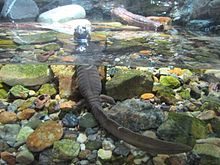| Japanese black salamander | |
|---|---|

| |
| Conservation status | |
 Least Concern (IUCN 3.1) | |
| Scientific classification | |
| Domain: | Eukaryota |
| Kingdom: | Animalia |
| Phylum: | Chordata |
| Class: | Amphibia |
| Order: | Urodela |
| Family: | Hynobiidae |
| Genus: | Hynobius |
| Species: | H. nigrescens |
| Binomial name | |
| Hynobius nigrescens Stejneger, 1907 | |
The Japanese black salamander (Hynobius nigrescens) is a species of salamander in the family Hynobiidae, endemic to Japan.
Its natural habitats are temperate forests, temperate grassland, swamps, freshwater marshes, intermittent freshwater marshes, irrigated land, canals and ditches.
When the larva goes through metamorphosis its gills and fins are replaced with lungs and legs. As the salamander grows, many of its muscles are shifted or are created in order to account for its size and weight.
References
- IUCN SSC Amphibian Specialist Group (2021). "Hynobius nigrescens". IUCN Red List of Threatened Species. 2021: e.T59099A177215161. doi:10.2305/IUCN.UK.2021-1.RLTS.T59099A177215161.en. Retrieved 17 November 2021.
- Omura, Ayano (2015). "Ontogenetic changes of trunk muscle structure in the Japanese black salamander (Hynobius nigrescens)". Journal of Veterinary Medical Science. 77 (8): 931–936. doi:10.1292/jvms.15-0011. PMC 4565815. PMID 25816856.
This salamander article is a stub. You can help Misplaced Pages by expanding it. |